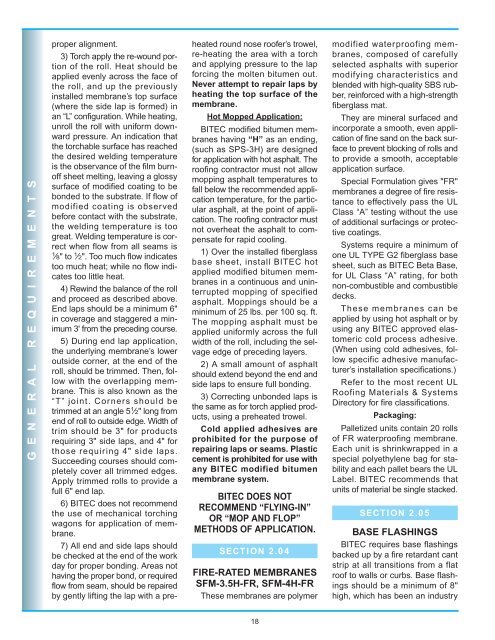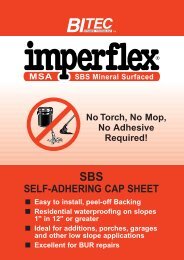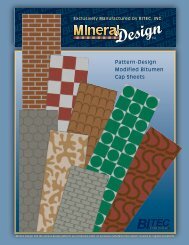Roofing Material Specifications and Details - BITEC, Bitumen ...
Roofing Material Specifications and Details - BITEC, Bitumen ...
Roofing Material Specifications and Details - BITEC, Bitumen ...
You also want an ePaper? Increase the reach of your titles
YUMPU automatically turns print PDFs into web optimized ePapers that Google loves.
G E N E R A L R E Q U I R E M E N T S<br />
proper alignment.<br />
3) Torch apply the re-wound portion<br />
of the roll. Heat should be<br />
applied evenly across the face of<br />
the roll, <strong>and</strong> up the previously<br />
installed membrane’s top surface<br />
(where the side lap is formed) in<br />
an “L” configuration. While heating,<br />
unroll the roll with uniform downward<br />
pressure. An indication that<br />
the torchable surface has reached<br />
the desired welding temperature<br />
is the observance of the film burnoff<br />
sheet melting, leaving a glossy<br />
surface of modified coating to be<br />
bonded to the substrate. If flow of<br />
modified coating is observed<br />
before contact with the substrate,<br />
the welding temperature is too<br />
great. Welding temperature is correct<br />
when flow from all seams is<br />
1 1 ⁄ 8" to ⁄ 2". Too much flow indicates<br />
too much heat; while no flow indicates<br />
too little heat.<br />
4) Rewind the balance of the roll<br />
<strong>and</strong> proceed as described above.<br />
End laps should be a minimum 6"<br />
in coverage <strong>and</strong> staggered a minimum<br />
3' from the preceding course.<br />
5) During end lap application,<br />
the underlying membrane’s lower<br />
outside corner, at the end of the<br />
roll, should be trimmed. Then, follow<br />
with the overlapping membrane.<br />
This is also known as the<br />
“T” joint. Corners should be<br />
trimmed at an angle 51 ⁄ 2" long from<br />
end of roll to outside edge. Width of<br />
trim should be 3" for products<br />
requiring 3" side laps, <strong>and</strong> 4" for<br />
those requiring 4" side laps.<br />
Succeeding courses should completely<br />
cover all trimmed edges.<br />
Apply trimmed rolls to provide a<br />
full 6" end lap.<br />
6) <strong>BITEC</strong> does not recommend<br />
the use of mechanical torching<br />
wagons for application of membrane.<br />
7) All end <strong>and</strong> side laps should<br />
be checked at the end of the work<br />
day for proper bonding. Areas not<br />
having the proper bond, or required<br />
flow from seam, should be repaired<br />
by gently lifting the lap with a pre-<br />
heated round nose roofer’s trowel,<br />
re-heating the area with a torch<br />
<strong>and</strong> applying pressure to the lap<br />
forcing the molten bitumen out.<br />
Never attempt to repair laps by<br />
heating the top surface of the<br />
membrane.<br />
Hot Mopped Application:<br />
<strong>BITEC</strong> modified bitumen membranes<br />
having “H” as an ending,<br />
(such as SPS-3H) are designed<br />
for application with hot asphalt. The<br />
roofing contractor must not allow<br />
mopping asphalt temperatures to<br />
fall below the recommended application<br />
temperature, for the particular<br />
asphalt, at the point of application.<br />
The roofing contractor must<br />
not overheat the asphalt to compensate<br />
for rapid cooling.<br />
1) Over the installed fiberglass<br />
base sheet, install <strong>BITEC</strong> hot<br />
applied modified bitumen membranes<br />
in a continuous <strong>and</strong> uninterrupted<br />
mopping of specified<br />
asphalt. Moppings should be a<br />
minimum of 25 lbs. per 100 sq. ft.<br />
The mopping asphalt must be<br />
applied uniformly across the full<br />
width of the roll, including the selvage<br />
edge of preceding layers.<br />
2) A small amount of asphalt<br />
should extend beyond the end <strong>and</strong><br />
side laps to ensure full bonding.<br />
3) Correcting unbonded laps is<br />
the same as for torch applied products,<br />
using a preheated trowel.<br />
Cold applied adhesives are<br />
prohibited for the purpose of<br />
repairing laps or seams. Plastic<br />
cement is prohibited for use with<br />
any <strong>BITEC</strong> modified bitumen<br />
membrane system.<br />
<strong>BITEC</strong> DOES NOT<br />
RECOMMEND “FLYING-IN”<br />
OR “MOP AND FLOP”<br />
METHODS OF APPLICATION.<br />
SECTION 2.04<br />
FIRE-RATED MEMBRANES<br />
SFM-3.5H-FR, SFM-4H-FR<br />
These membranes are polymer<br />
18<br />
modified waterproofing membranes,<br />
composed of carefully<br />
selected asphalts with superior<br />
modifying characteristics <strong>and</strong><br />
blended with high-quality SBS rubber,<br />
reinforced with a high-strength<br />
fiberglass mat.<br />
They are mineral surfaced <strong>and</strong><br />
incorporate a smooth, even application<br />
of fine s<strong>and</strong> on the back surface<br />
to prevent blocking of rolls <strong>and</strong><br />
to provide a smooth, acceptable<br />
application surface.<br />
Special Formulation gives "FR"<br />
membranes a degree of fire resistance<br />
to effectively pass the UL<br />
Class “A” testing without the use<br />
of additional surfacings or protective<br />
coatings.<br />
Systems require a minimum of<br />
one UL TYPE G2 fiberglass base<br />
sheet, such as <strong>BITEC</strong> Beta Base,<br />
for UL Class “A” rating, for both<br />
non-combustible <strong>and</strong> combustible<br />
decks.<br />
These membranes can be<br />
applied by using hot asphalt or by<br />
using any <strong>BITEC</strong> approved elastomeric<br />
cold process adhesive.<br />
(When using cold adhesives, follow<br />
specific adhesive manufacturer’s<br />
installation specifications.)<br />
Refer to the most recent UL<br />
<strong>Roofing</strong> <strong>Material</strong>s & Systems<br />
Directory for fire classifications.<br />
Packaging:<br />
Palletized units contain 20 rolls<br />
of FR waterproofing membrane.<br />
Each unit is shrinkwrapped in a<br />
special polyethylene bag for stability<br />
<strong>and</strong> each pallet bears the UL<br />
Label. <strong>BITEC</strong> recommends that<br />
units of material be single stacked.<br />
SECTION 2.05<br />
BASE FLASHINGS<br />
<strong>BITEC</strong> requires base flashings<br />
backed up by a fire retardant cant<br />
strip at all transitions from a flat<br />
roof to walls or curbs. Base flashings<br />
should be a minimum of 8"<br />
high, which has been an industry




